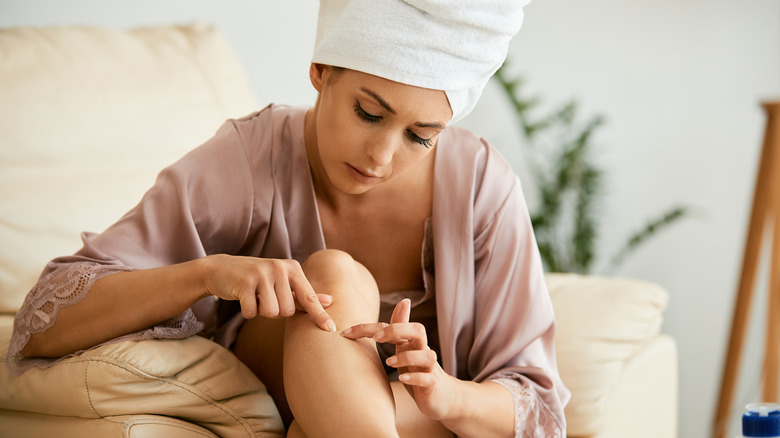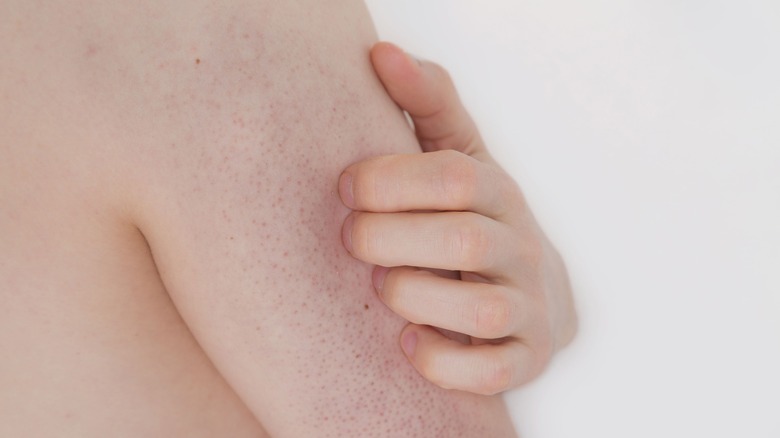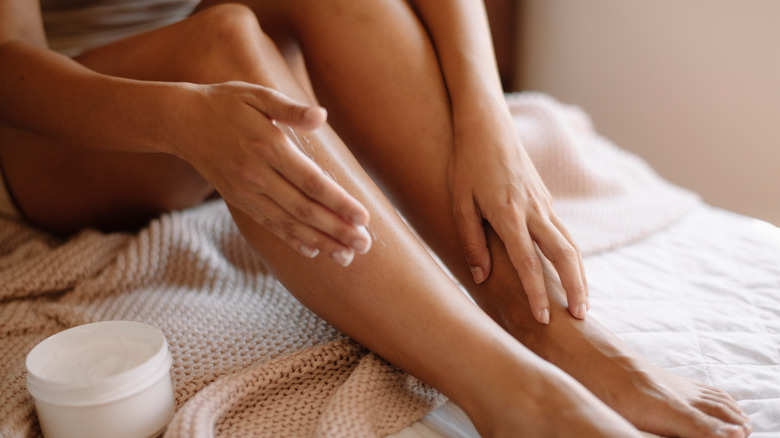What Are Keratin Plugs And What Can You Do To Treat Them?
If social media had its way — with all of its filters and airbrushing — it would have us believing that our skin is meant to be porcelain-smooth and our coloring perfectly even. But in real life, skin is marked with lovely little laugh lines, dark spots where the sun has kissed us time and time again, and tiny bumps — here, there, and everywhere.
Some of these little bumps may be caused by sebum plugs, or pimples, which form when our hair follicles get clogged with sebum and dead skin cells (per Mayo Clinic). Bacteria thrive inside these sebum plugs, creating an infection that often results in the pesky red bumps we call acne.
However, you may notice that there are other bumps on your skin which, unlike pimples, aren't inflamed. Typically found on the upper arms, thighs, and buttocks, these often white, pink, or skin-colored bumps are called keratin plugs.
Keratin plugs can occur when our old skin doesn't shed
Every surface on our body is made up of epithelial cells. Each of these cells contain a fibrous protein called keratin, which gives structure to our hair, skin, and nails (per National Cancer Institute).
When our skin gets to work making new skin cells, the magic happens in the deeper layers of the epidermis. As new skin cells are produced, the old skin cells are pushed to the surface of the skin (per Study.com). When these dead skin cells — made mostly of keratin — aren't sloughed off as they should be, they can become lodged in our fair follicles, creating tiny bumps called keratin plugs. While it remains unclear why this happens, it's believed that irritation as a result of friction and dry skin can play a role (per Cleveland Clinic).
Often white, pink, or skin-colored, keratin plugs don't hurt like pimples can. They often appear in patches on the arms, thighs, and buttocks, creating a sandpapery texture that you might hear referred to as "chicken skin." While the bumps may become itchy, it's usually a result of dry skin.
Keratin plugs can appear on anyone, but they're most commonly found on tweens and teenagers, and affect as many as 80% of adolescents. If keratin plugs are plentiful, it may be an indicator of a condition called keratosis pilaris, which can occur when there is an excess of keratin in the skin. Asthma, obesity, hay fever, dry skin, eczema, and genetics can contribute to the incidence of keratosis pilaris.
How to treat keratin plugs
While there are no specialized tests to determine whether or not the bumps on your skin are the result of keratin plugs, a diagnosis can be achieved through a visit to your healthcare provider or dermatologist (per Cleveland Clinic). They will be able to diagnose the condition just by looking at it.
Keratin plugs don't require any kind of medical treatment, as they don't pose any threat and often clear up on their own. However, in some cases, they may be stubborn and hard to get rid of. If their appearance is bothersome to you, there are some ways you can help to treat them.
Over-the-counter and prescription topical peels containing lactic and salicylic acid can be used as a gentle exfoliator, helping to release trapped dead skin cells (per Healthline). Using a dry brush or washcloth on the skin can also help with this process. The Cleveland Clinic points out that you can also reduce the appearance of existing keratin plugs — and even prevent new ones from forming — by keeping the skin well moisturized. Refraining from wearing tight-fitting clothes that can rub against the skin and using lukewarm water during bath time can also reduce skin irritation and improve keratin plugs. In the event that the bumps won't go away or keep returning, your doctor may recommend a procedure like dermabrasion or laser skin resurfacing for a more extreme form of exfoliation.



